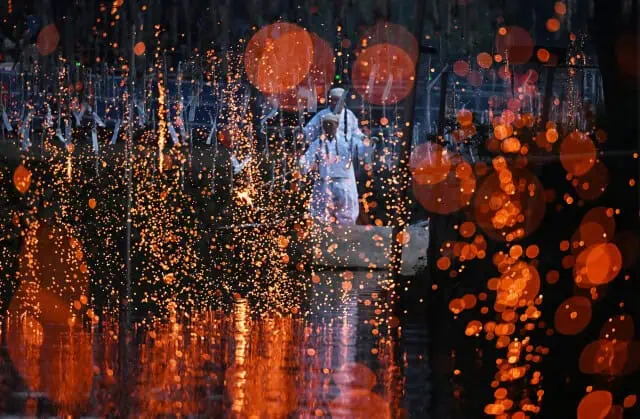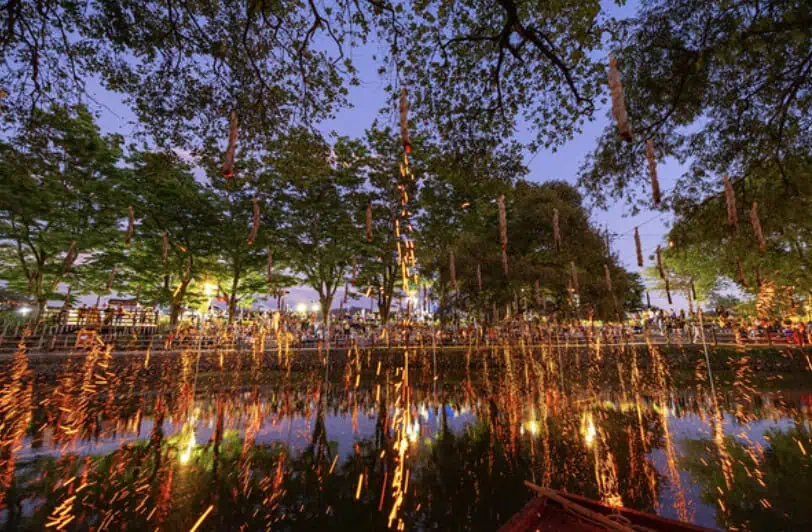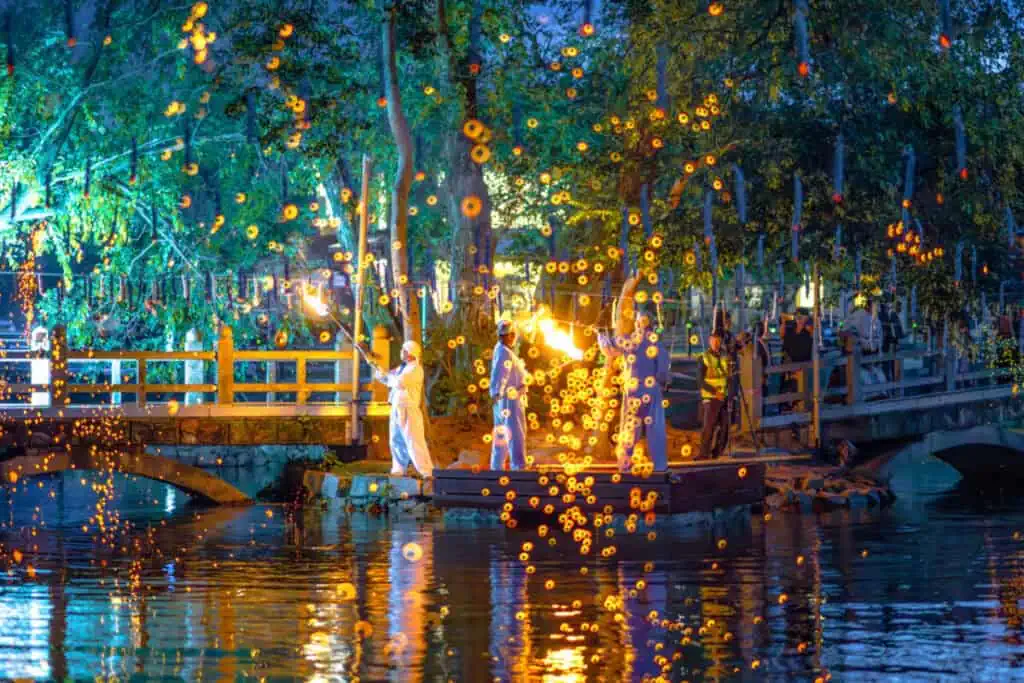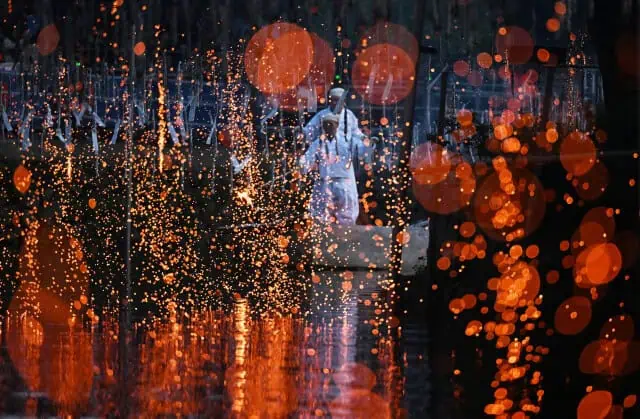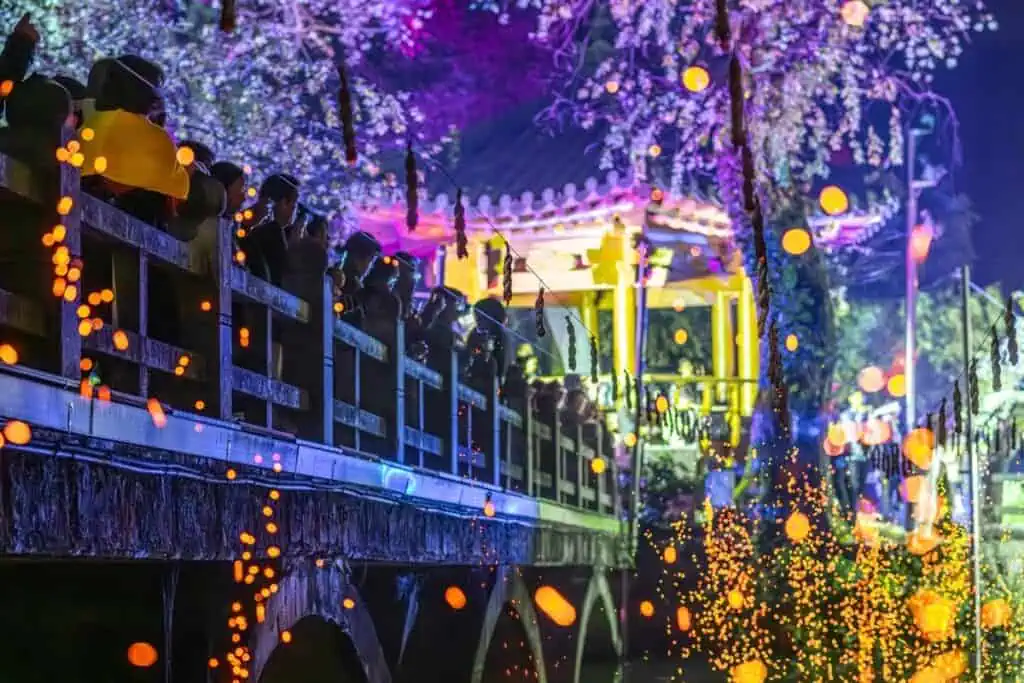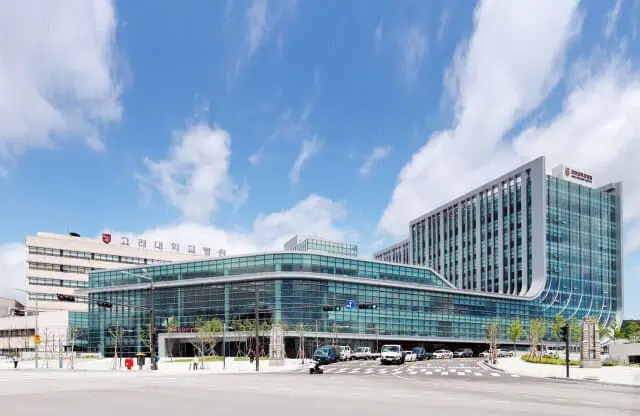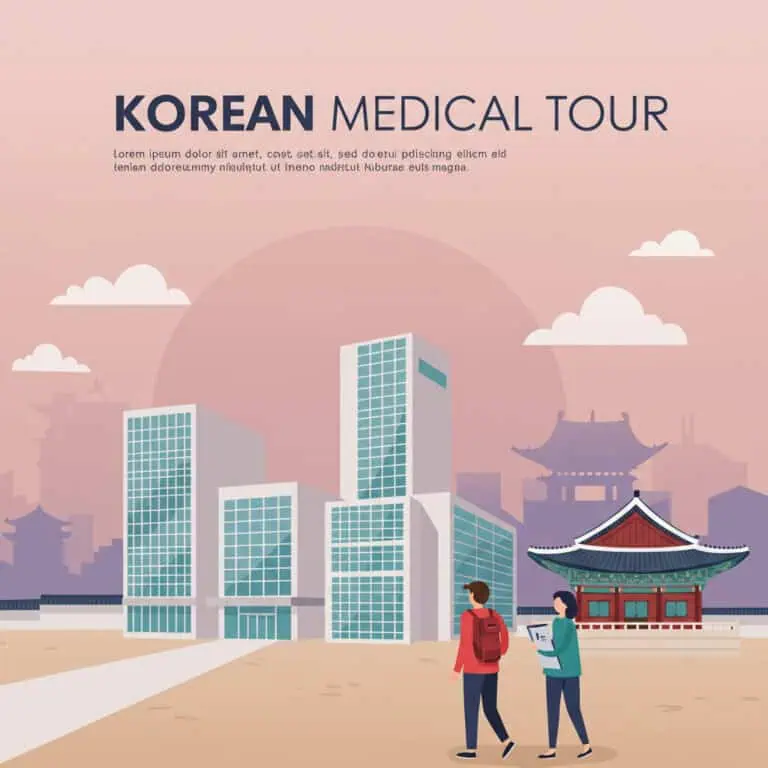The Magical Haman Nakhwa Festival 2025: Experience Korea’s Stunning Cascade of Light
By Jay Kim
Imagine not fireworks soaring into the sky, but thousands of fiery blossoms cascading down like a gentle rainfall, creating a river of golden light reflected in the still waters below. This breathtaking spectacle awaits you at South Korea’s enchanting Haman Nakhwa Festival. Located in the charming Haman County, this unique, centuries-old tradition offers a mesmerizing experience incomparable to any other fireworks display. This year, the magic unfolds on May 5th, which is Children’s Day—a special holiday that will provide unforgettable moments for visitors of all ages. Dive into the meaning behind these “flowers of fire,” immerse yourself in the festival’s rich history, and gather all the practical information you need to visit this shimmering spectacle.
What is Nakhwa?
“Nakhwa” (落火) literally means “falling fire,” though the visual effect more closely resembles “falling flowers” (落花). This mesmerizing display is created through a meticulous process. Local residents carefully wrap oak charcoal powder in traditional Korean paper made from mulberry trees (Hanji) to create the “fireworks.” These bundles are suspended on long strings between lanterns hung over the tranquil waters of Mujinjeong Pond. When evening falls, these charcoal-filled papers are lit, slowly burning to create a stunning rain of sparkling embers.
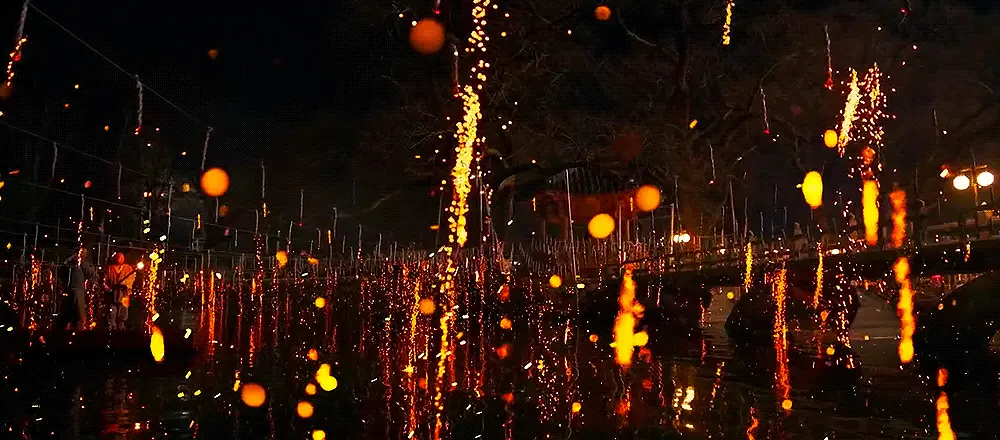
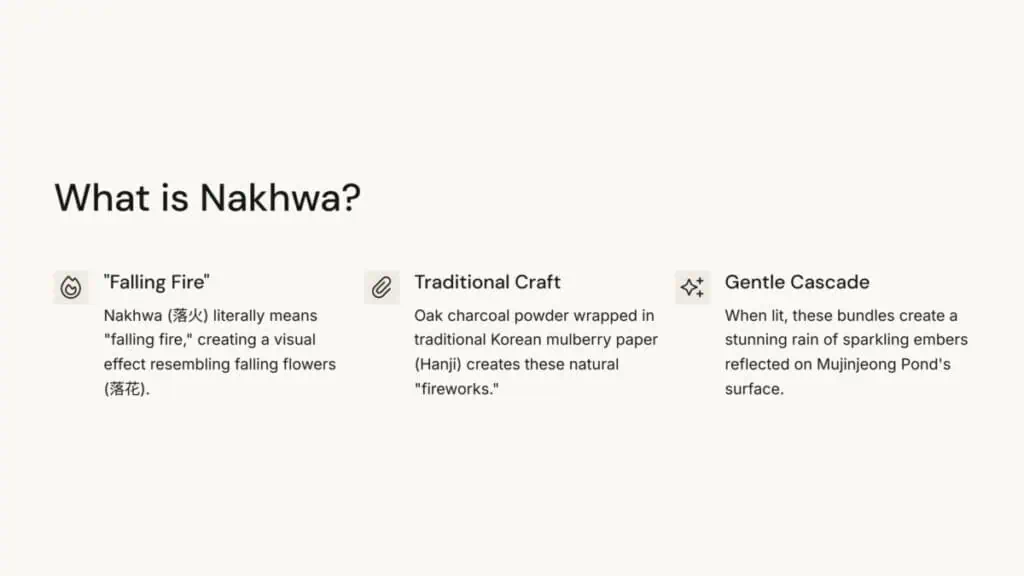
Unlike conventional fireworks that use gunpowder, the Nakhwa Festival utilizes the natural properties of oak charcoal, making it not only unique but also deeply rooted in tradition and environmentally gentle. The visual result is truly captivating—thousands of tiny embers falling like delicate petals, beautifully reflected on the water’s surface, creating a waterfall of sparks. Some compare this scene to countless fireflies dancing against the night sky, a poetic image that perfectly captures the serene yet brilliant essence of the Nakhwa Festival.
A Journey Through History and Culture
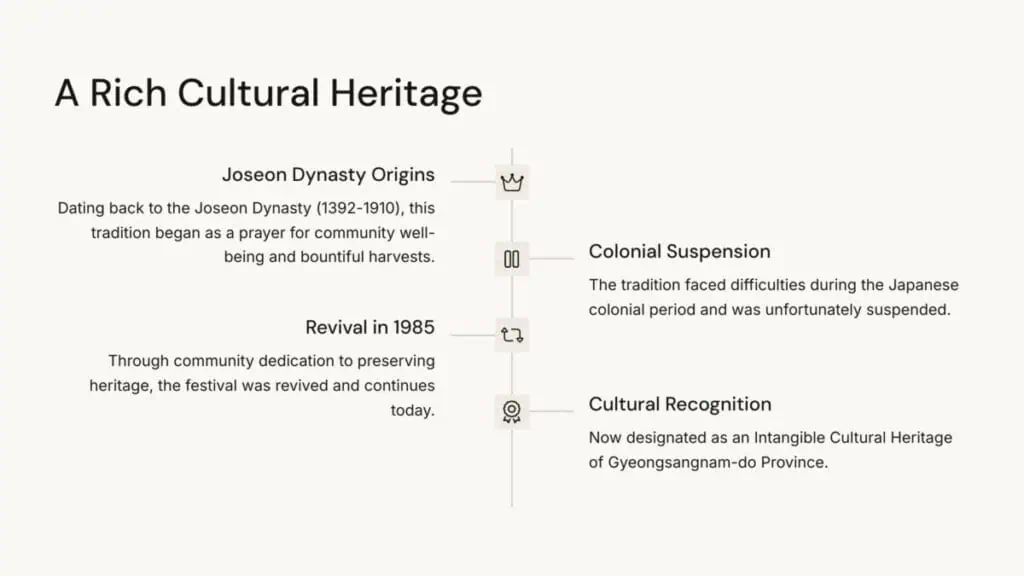
The Haman Nakhwa Festival is not a fleeting modern invention but a treasured tradition dating back to the Joseon Dynasty (1392-1910). For generations, this fascinating event has been held annually around Buddha’s Birthday in April or May. The festival’s original purpose was to pray for the community’s well-being, peace, and a bountiful harvest. This year, it coincides with Children’s Day on May 5th, adding deeper significance to the occasion.
At the heart of the Nakhwa Festival stands the picturesque Mujinjeong Pavilion (無盡亭). Surrounded by a tranquil pond, this beautiful structure provides the perfect backdrop for the fireworks. Beyond visual splendor, the Nakhwa tradition holds deep cultural significance. It’s believed to chase away bad luck and bring blessings to the community. Historically, similar fire-related traditions were associated with community gatherings, and in some regions, they were used as military signals.
Recognizing its profound cultural value, the Haman Nakhwa Festival has been designated as an Intangible Cultural Heritage of Gyeongsangnam-do Province, affirming its authenticity and importance. Like many Korean cultural traditions, the Nakhwa Festival faced difficulties during the Japanese colonial period and was unfortunately suspended. However, through the community’s dedication to preserving its heritage, it was revived in 1985 and is now celebrated annually to pray for the well-being of Haman’s residents—a symbol of resilience and cultural pride.
Special Children’s Day Delights
Mark your calendars! May 5th in Korea is a very special day—Children’s Day (어린이날). This national holiday celebrates children and their importance to the nation. It’s a day when families gather to spend joyful time together, showering children with love, often with fun outings, special treats, and memorable activities. What could be more memorable than witnessing the magical Haman Nakhwa Festival? Imagine children’s delight as they watch the sparkling “flowers of fire” gently descend under the twilight sky.
This unique event offers visiting families a fantastic opportunity to create a truly special and enchanting experience for their children. With the lovely national holiday for children combined with a breathtaking traditional spectacle, May 5th is the ideal time to visit Haman.
Travel Planning: Getting to Haman
Planning your journey to experience the Haman Nakhwa Festival is essential. Here’s a guide on how to get to Haman from Seoul and Busan.
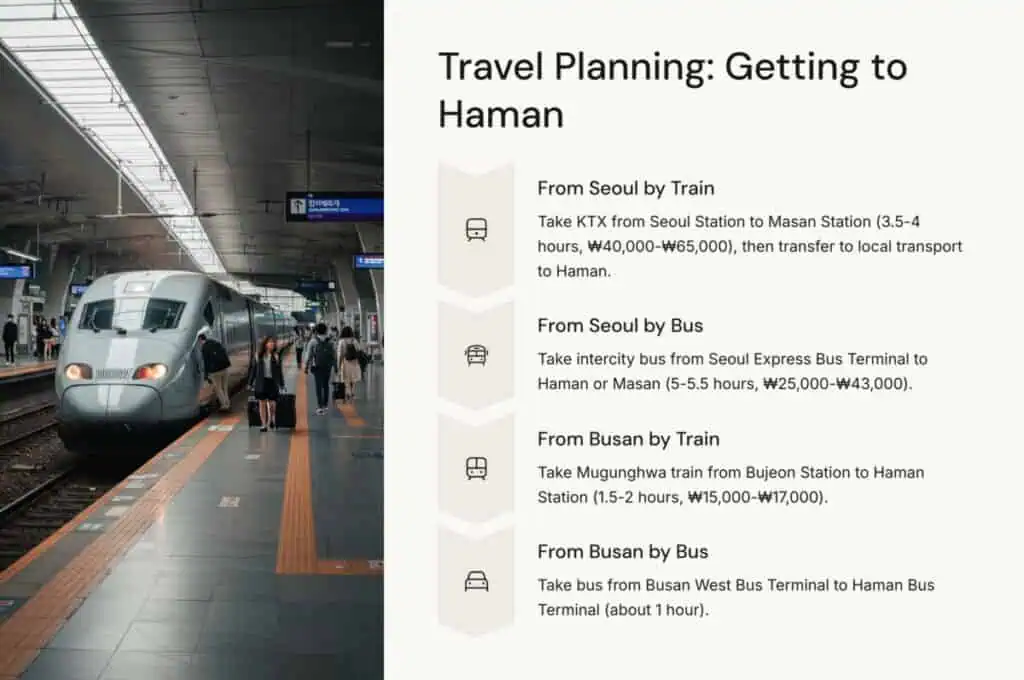
From Seoul:
Transportation:
Train (KTX): The most common and generally fastest way to get from Seoul to the Haman area is to take the KTX high-speed train from Seoul Station to Masan Station. Travel time is typically around 3.5 to 4 hours, with ticket prices ranging from approximately ₩40,000 to ₩65,000. Upon arriving at Masan Station, you’ll likely need to transfer to a local bus or another train to reach Haman. Direct train options from Seoul to Haman Station may be fewer or slower, but the route via Masan is generally more convenient.
Bus: Another option is to take an intercity bus from Seoul Express Bus Terminal or Seoul Southern Terminal to nearby cities like Haman or Masan. The bus journey takes longer, approximately 5 to 5.5 hours, but tickets are often cheaper, ranging from about ₩25,000 to ₩43,000. Some bus routes might go directly to Haman, while others might require a transfer at Masan.
Recommended Day Trip Itinerary (From Seoul):
A day trip from Seoul to the Haman Nakhwa Festival is possible, but it will be a long day. Here’s a possible itinerary:
| Time | Activity | Notes |
|---|---|---|
| 7:00 AM | Depart Seoul Station on KTX to Masan | Check KTX timetables and book in advance (Korail website/app) |
| 10:30 AM | Arrive at Masan Station | |
| 10:30 – 11:15 AM | Travel to Haman (bus/taxi) | Check local bus schedules, or a taxi will get you there faster |
| 11:15 AM – Evening | Explore Haman (lunch, sightseeing) | See recommended places in the “Beyond the Fireworks” section |
| Evening | Enjoy the Nakhwa Festival at Mujinjeong | Festival times are typically in the evening |
| After 9:30 PM | Dinner in Haman | |
| Late night | Depart Masan for Seoul on KTX | Check last KTX timetables carefully to not miss it |
From Busan:
Transportation:
Train (Mugunghwa/KTX): Traveling by train from Busan to Haman is generally more direct than from Seoul. You can take a train from Busan (likely from Bujeon Station) to Haman Station. A Mugunghwa train journey takes about 1.5 to 2 hours, with ticket prices around ₩15,000 to ₩17,000. KTX connects Busan with nearby cities like Masan, but direct KTX service to Haman may be limited or not a primary option.
Bus: Taking a bus from Busan West Bus Terminal (also known as Sasang Terminal) to Haman Bus Terminal is another convenient option. The bus journey is slightly faster than the Mugunghwa train, taking about 1 hour, and costs would be similar to train fares.
Recommended Day Trip Itinerary (From Busan):
A day trip from Busan to the Haman Nakhwa Festival is very feasible due to the shorter travel time. Here’s a possible itinerary:
| Time | Activity | Notes |
|---|---|---|
| 9:00 AM | Depart Busan (Bujeon Station) for Haman | Check train timetables and book in advance (Korail website/app) |
| 10:30 AM | Arrive at Haman Station | |
| 10:30 AM – Evening | Explore Haman (lunch, sightseeing) | See recommended places in the “Beyond the Fireworks” section |
| Evening | Enjoy the Nakhwa Festival at Mujinjeong | Festival times are typically in the evening |
| Late evening | Dinner in Haman | |
| After 9:30 PM | Depart Haman for Busan via bus or train | Check return bus and train schedules. Buses might offer a slightly faster return |
Reservation Required: Ticket Booking on Yes24
Important information for international tourists planning to see the Haman Nakhwa Festival on May 5th: Reservations open on March 26th at 10 AM (Korean Standard Time) on the Yes24 website. The number of tickets available to the general public is limited to 5,700, and considering the festival’s popularity, they are likely to sell out quickly. Therefore, it’s advisable to plan ahead and be ready to book as soon as tickets go on sale.
On-site purchases are not possible, so advance reservation is mandatory. To book tickets, you’ll need to access the Yes24 website. For international users, the English version of the Yes24 ticket website is available at http://ticket.yes24.com/English. The exact booking procedure may vary slightly, but generally, you can expect these steps:
- Select Date: Navigate to the Haman Nakhwa Festival event page on the website and select the date you want to attend, which is May 5th.
- Select Ticket Quantity: Indicate the number of tickets you need. Note that there may be a limit on the number of tickets allowed per person.
- Select Seats (if applicable): The Nakhwa Festival is primarily a standing event around the pond, so seat selection may not apply. However, if there are designated viewing areas with seating, you might select your preferred spots at this stage.
- Proceed to Payment: Once you’ve selected your tickets, proceed to the payment page. For international users, card payment (credit or debit card) is likely to be the only option allowed. Have your card information ready.
- Reservation Confirmation: After completing the payment, you should receive a confirmation email or message with your booking details. It’s important to verify that your reservation has been successfully completed.
You may need to create an account on Yes24 to complete the booking process. It’s also a good idea to familiarize yourself with the cancellation and refund policy on the Yes24 website before booking. On the day of the festival, entry may be managed using QR codes, so prepare a digital ticket or printed copy, and note that screenshots of QR codes may not be accepted.
Beyond the Fireworks: Explore More of Haman
To make the most of your day trip to Haman, consider exploring other fascinating attractions this area has to offer:
- Malisan Tumuli (말이산고분군): History enthusiasts will be fascinated by the Malisan Tumuli, ancient tombs of the Gaya Kingdom recently designated as a UNESCO World Heritage site. This important archaeological site offers a glimpse into the region’s rich past.
- Haman Museum (함안박물관): Located near the Malisan Tumuli, the Haman Museum provides deeper insights into the history and culture of the Gaya Kingdom and the Haman region.
- Akyang Riverside Walk (악양둑방): For nature lovers, the Akyang Riverside Walk is a beautiful riverside path where vibrant poppies bloom, especially in spring. It’s a perfect spot for a leisurely stroll and enjoying the countryside scenery.
- Lotus Theme Park (연꽃테마파크): If you have extra time, particularly if visiting in a slightly later season, the Lotus Theme Park (Yeonhwa Wetland) is a peaceful and beautiful spot.
- Gangju Sunflower Village (강주해바라기마을): While best visited when sunflowers are in full bloom in late summer or early autumn, the Gangju Sunflower Village is another popular attraction in Haman.
- Goryeodong Historic Site (고려동유적지): Step back in time at the Goryeodong Historic Site, a historical settlement where Goryeo loyalists went into hiding to maintain their allegiance after the fall of the Goryeo Dynasty. This village offers a unique glimpse into a different era of Korean history.
- Ipgok County Park (입곡군립공원): This beautiful park features a reservoir and scenic walking paths, offering a refreshing natural retreat.
Depending on your interests and available time, you can easily include one or two of these attractions in your day trip itinerary from either Seoul or Busan. For instance, visitors traveling from Busan might find it convenient to visit the Malisan Tumuli or Haman Museum before watching the Nakhwa at Mujinjeong in the evening.
Conclusion
The Haman Nakhwa Festival offers a truly unique and magical experience that will leave a deep and lasting impression. The spectacle of “falling fire” gently cascading under the night sky is a captivating blend of tradition, culture, and natural beauty. With this year’s festival falling on Children’s Day, it presents an even more special opportunity for families to create unforgettable memories. So plan your journey now, mark March 26th on your calendar for ticket reservations, and prepare to be enchanted by the shimmering spectacle of Korea’s Haman Nakhwa Festival!
Official video LInk

